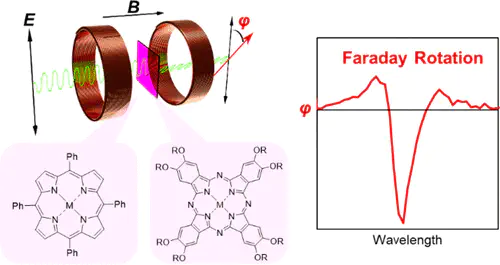
Abstract
The magneto-optical phenomenon known as Faraday rotation involves the rotation of plane-polarized light as it passes through an optical medium in the presence of an external magnetic field oriented parallel to the direction of light propagation. Faraday rotators find applications in optical isolators and magnetic-field imaging technologies. In recent years, organic thin films comprised of polymeric and small-molecule chromophores have demonstrated Verdet constants, which measure the magnitude of rotation at a given magnetic field strength and material thickness, that exceed those found in conventional inorganic crystals. We report herein the thin-film magnetic circular birefringence (MCB) spectra and maximum Verdet constants of several commercially available and newly synthesized phthalocyanine and porphyrin derivatives. Five of these species achieved maximum Verdet constant magnitudes greater than 105 deg T–1 m–1 at wavelengths between 530 and 800 nm. Notably, a newly reported zinc(II) phthalocyanine derivative (ZnPc-OT) reached a Verdet constant of −33 × 104 deg T–1 m–1 at 800 nm, which is among the largest reported for an organic material, especially for an optical-quality thin film. The MCB spectra are consistent with resonance-enhanced Faraday rotation in the region of the Q-band electronic transition common to porphyrin and phthalocyanine derivatives, and the Faraday A-term describes the electronic origin of the magneto-optical activity. Overall, we demonstrate that phthalocyanines and porphyrins are a class of rationally designed magneto-optical materials suitable for applications demanding large Verdet constants and high optical quality.